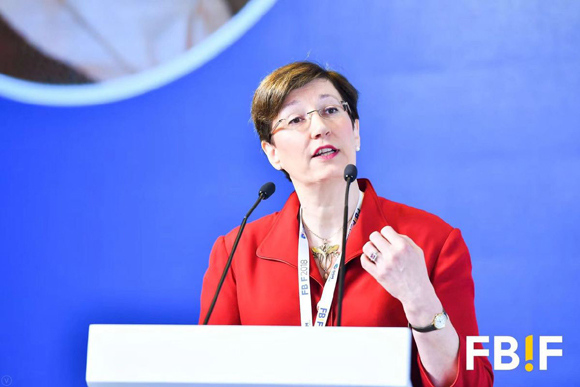
Isabelle Esser, executive vice president for research development foods at Unilever, delivers a keynote speech at the Food and Beverage Innovation Forum 2018 in Shanghai on April 18, 2018. (Photo provided to chinadaily.com.cn)
Food tastes tend to grow more specific and diverse amid Asian population shifts, rapid urbanization and lifestyle changes, said Isabelle Esser, executive vice president for food research and development at Unilever, in a keynote speech on Wednesday.
The rising middle class in Asia will be dominant in the next several decades, she said. Today, about a half of the middle-class population live in Asia, and the figure is expected to increase to two thirds by 2030. Middle-class consumption also follows the same trend - Asia will account for 60 percent by 2030, and North America and Europe combined will come in at 30 percent.
Along with that, milllennials are becoming prime consumers. The late-20th-century-born generation is deeply influenced by the internet and social media. Esser cited data in her speech while attending the Food and Beverage Innovation Forum 2018 that two-thirds of future consumption growth in China will be contributed by milllennials.
Factoring in aging and Muslim population growing, such factors as diversified tastes, high quality, healthy diets, convenience and awareness of sustainability are among consumption demand changes.
In October 2016, China released "Healthy China 2030," a blueprint that covers areas such as public health services, the medical industry and food and drug safety with the aim of improving the health of the Chinese people. The country plans to increase average life expectancy to 77.3 by 2020, and 79 by 2030.
Esser cited data in 2016 showing around 67 percent of consumers in Southeast Asia hope to purchase products without artificial pigments and 82 percent of Chinese consumers are willing to pay a higher price for organic food and those with better-quality ingredients.
In terms of researching and developing products, "Social media is very important for food and it's completely changing the landscape now," Esser told China Daily Website at the sidelines of the forum.
"Food is actually discussed a lot on social media, not only the food that people eat and posting what it is, but also the big trends in nutrition, health and well-being. It's something we have to take into account, absolutely," she said.
At the same time, Esser also pointed out that looking into and understanding trends, markets and consumer needs play a big role the researching and developing process.


















































